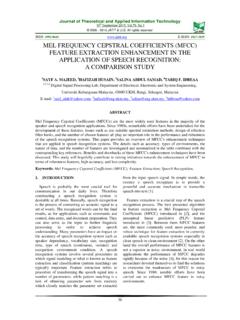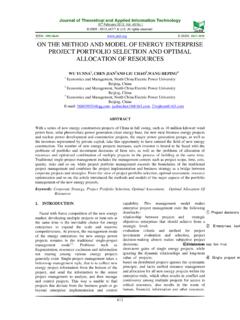Transcription of BUSINESS INTELLIGENCE: CONCEPTS, COMPONENTS, …
1 Journal of Theoretical and Applied Information Technology 2005 - 2009 JATIT. All rights reserved. 60 Vol 9. No 1. (pp 060 - 070) BUSINESS INTELLIGENCE: CONCEPTS, COMPONENTS, TECHNIQUES AND BENEFITS JAYANTHI RANJAN Institute of Management Technology, Ghaziabad, Uttar Pradesh, India Email: ABSTRACT For companies maintaining direct contact with large numbers of customers, however, a growing number channel-oriented applications ( e-commerce support, call center support) create a new data management challenge: that is effective way of integrating enterprise applications in real time.
2 To learn from the past and forecast the future, many companies are adopting BUSINESS Intelligence (BI) tools and systems. Companies have understood the importance of enforcing achievements of the goals defined by their BUSINESS strategies through BUSINESS intelligence concepts. It describes the insights on the role and requirement of real time BI by examining the BUSINESS needs. The paper explores the concepts of BI, its components, emergence of BI, benefits of BI, factors influencing BI, technology requirements, designing and implementing BUSINESS intelligence, and various BI techniques. 1. INTRODUCTION BUSINESS intelligence (BI) has two basic different meanings related to the use of the term intelligence.
3 The primary, less frequently, is the human intelligence capacity applied in BUSINESS affairs/activities. Intelligence of BUSINESS is a new field of the investigation of the application of human cognitive faculties and artificial intelligence technologies to the management and decision support in different BUSINESS problems. The second relates to the intelligence as information valued for its currency and relevance. It is expert information, knowledge and technologies efficient in the management of organizational and individual BUSINESS . Therefore, in this sense, BUSINESS intelligence is a broad category of applications and technologies for gathering, providing access to, and analyzing data for the purpose of helping enterprise users make better BUSINESS decisions.
4 The term implies having a comprehensive knowledge of all of the factors that affect the BUSINESS . It is imperative that firms have an in depth knowledge about factors such as the customers, competitors, BUSINESS partners, economic environment, and internal operations to make effective and good quality BUSINESS decisions. BUSINESS intelligence enables firms to make these kinds of decisions. A specialized field of BUSINESS intelligence known as competitive intelligence focuses solely on the external competitive environment. Information is gathered on the actions of competitors and decisions are made based on this information.
5 Little if any attention is paid to gathering internal information. In modern businesses, increasing standards, automation, and technologies have led to vast amounts of data becoming available. Data warehouse technologies have set up repositories to store this data. Improved Extract, transform, load (ETL) and even recently Enterprise Application Integration tools have increased the speedy collecting of data. OLAP reporting technologies have allowed faster generation of new reports which analyze the data. BUSINESS intelligence has now become the art of sifting through large amounts of data, extracting pertinent information, and turning that information into knowledge upon which actions can be taken.
6 The paper explores the concepts of BI, its components, emergence of BI, benefits of BI, factors influencing BI, technology requirements, designing and implementing BUSINESS intelligence, cultural imperatives, and various BI techniques. The paper would be useful for Journal of Theoretical and Applied Information Technology 2005 - 2009 JATIT. All rights reserved. 61 Vol 9. No 1. (pp 060 - 070) budding researchers in the field of BI to understand the basic concepts. 2. BUSINESS INTELLIGENCE Stackowiak et al. (2007) define BUSINESS intelligence as the process of taking large amounts of data, analyzing that data, and presenting a high-level set of reports that condense the essence of that data into the basis of BUSINESS actions, enabling management to make fundamental daily BUSINESS decisions.
7 (Cui et al, 2007) view BI as way and method of improving BUSINESS performance by providing powerful assists for executive decision maker to enable them to have actionable information at hand. BI tools are seen as technology that enables the efficiency of BUSINESS operation by providing an increased value to the enterprise information and hence the way this information is utilized. Zeng et al. (2006) define BI as The process of collection, treatment and diffusion of information that has an objective, the reduction of uncertainty in the making of all strategic decisions.
8 Experts describe BUSINESS intelligence as a BUSINESS management term used to describe applications and technologies which are used to gather, provide access to analyze data and information about an enterprise, in order to help them make better informed BUSINESS decisions. (Tvrd kov , 2007) describes the basic characteristic for BI tool is that it is ability to collect data from heterogeneous source, to possess advance analytical methods, and the ability to support multi users demands. Zeng et al. (2006) categorized BI technology based on the method of information delivery; reporting, statistical analysis, ad-hoc analysis and predicative analysis.
9 The concept of BUSINESS Intelligence (BI) is brought up by Gartner Group since 1996. It is defined as the application of a set of methodologies and technologies, such as J2EE, DOTNET, Web Services, XML, data warehouse, OLAP, Data Mining, representation technologies, etc, to improve enterprise operation effectiveness, support management/decision to achieve competitive advantages. BUSINESS Intelligence by today is never a new technology instead of an integrated solution for companies, within which the BUSINESS requirement is definitely the key factor that drives technology innovation. How to identify and creatively address key BUSINESS issues is therefore always the major challenge of a BI application to achieve real BUSINESS impact.
10 (Golfarelli , 2004) defined BI that includes effective data warehouse and also a reactive component capable of monitoring the time-critical operational processes to allow tactical and operational decision-makers to tune their actions according to the company strategy. (Gangadharan and Swamy, 2004) define BI as the result of in-depth analysis of detailed BUSINESS data, including database and application technologies, as well as analysis practices. (Gangadharan and Swamy, 2004) widen the definition of BI as technically much broader tools, that includes potentially encompassing knowledge management, enterprise resource planning, decision support systems and data mining.
















